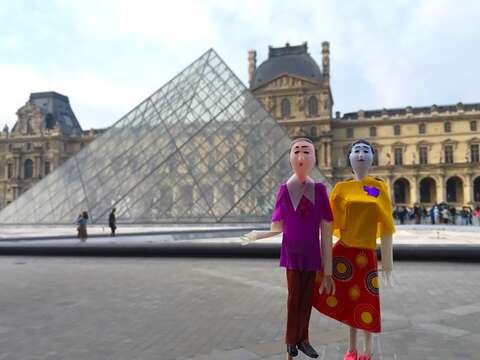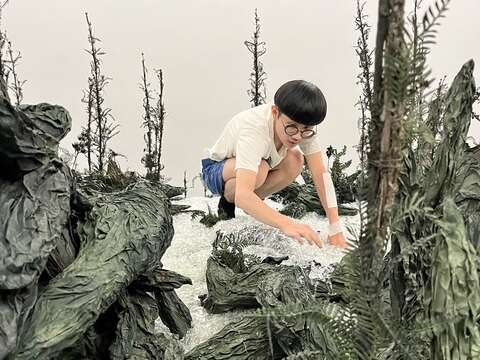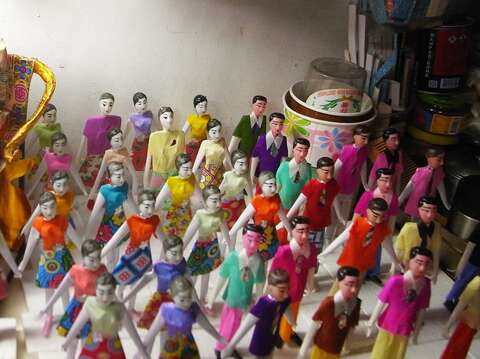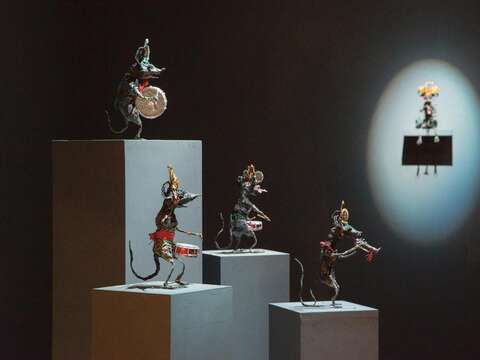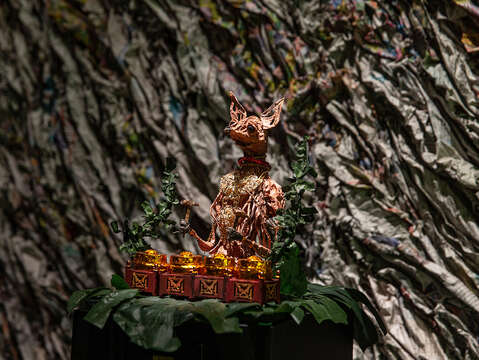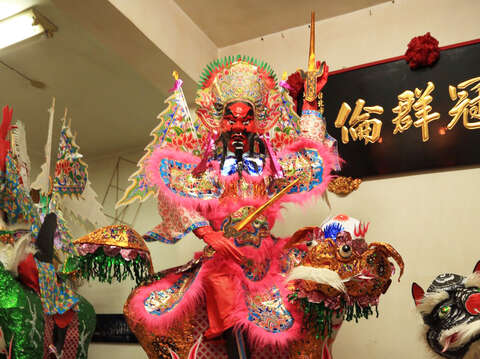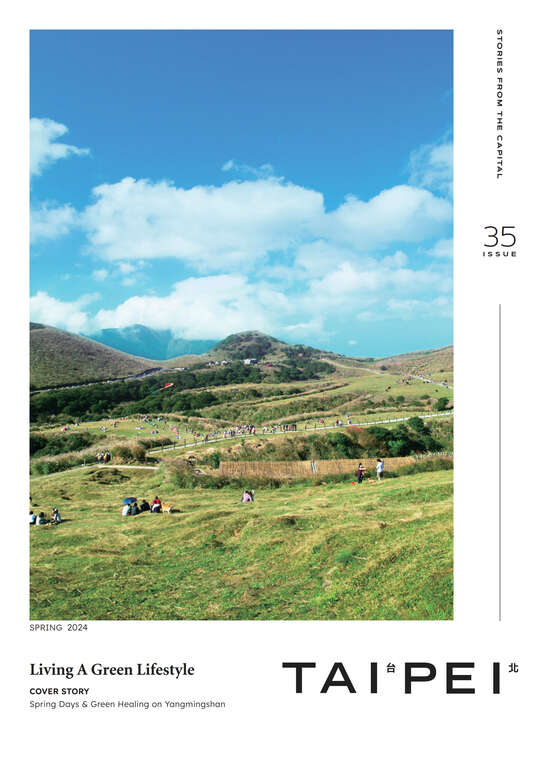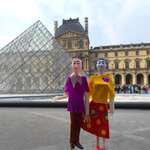Post date:2024-03-11
122
TAIPEI #35 (2024 Spring)
An Ancient Blessing Culture: The Story of Paper Art
Author Jenna Lynn Cody
Photographer Hsin Hsin Paper Offering Store, Zhang Xu Zhan
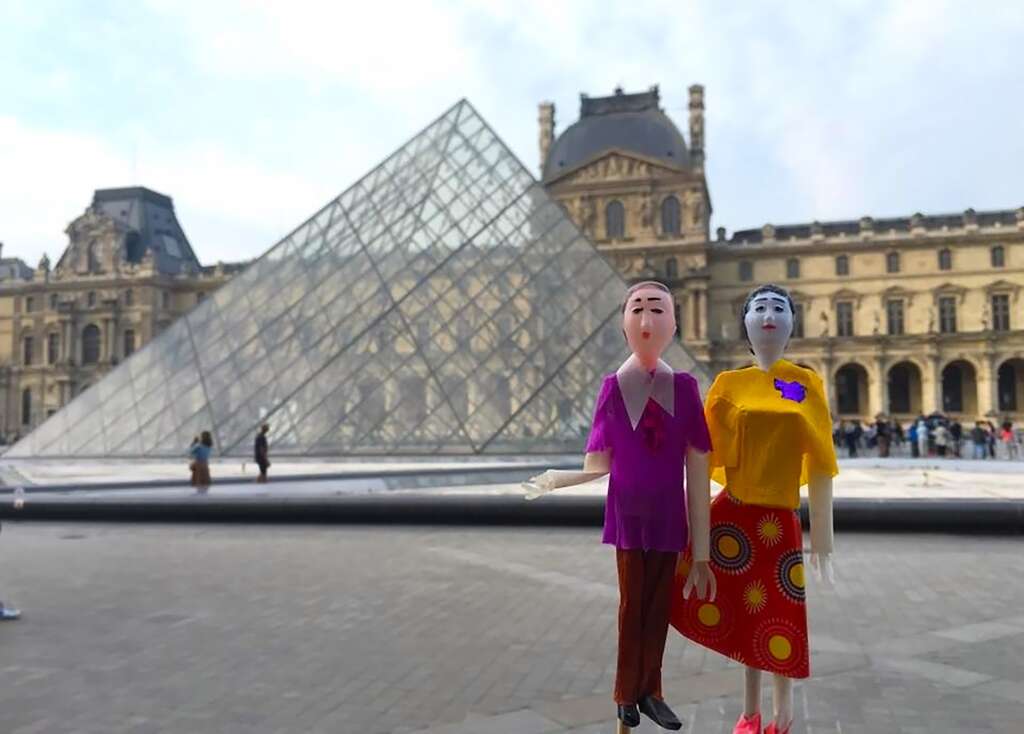 ▲Taiwan's traditional paper offering art has been exhibited for the second time in Paris, allowing the world to see. (Photo・Hsin Hsin Paper Offering Store)
▲Taiwan's traditional paper offering art has been exhibited for the second time in Paris, allowing the world to see. (Photo・Hsin Hsin Paper Offering Store)
Imagine an opulent mansion. Perhaps it's anachronistic in design and covered in improbably bright shades of pink, green or yellow. Perhaps, instead, it is sleekly modern, done in neutral tones — what a wealthy person living in Taiwan today might build for themselves. Add to your mansion a luxury car, a designer handbag and shoes, and all the money you could ever want.
You might see these items, rendered in uncannily realistic detail, at a Taiwanese funeral, or ceremony paying respects to those no longer with us. All of them are painstakingly rendered in paper and bamboo, and all of them will go up in flames. They're not for us; they're for the afterlife.
Paper offerings take on special meaning in early April, when Taiwanese people visit their ancestors' graves. Both paper money and more elaborate paper offerings are often burned to pay one's respects to those who have passed on. Although the art of paper offerings is thousands of years old and found in Chinese-speaking communities around the world, Taiwanese paper artists have been breaking new ground with creative paper renderings and even short films. Such art has garnered significant international attention, including multiple feature exhibitions in France, such as one that took place at Musée du Quai Branly, among others.
When learning about paper offering art, one must consider not only its history and cultural connotations, but also the ways it has transformed itself into a modern art form for contemporary audiences.
Paper Art Through Life and Death
Paper offerings, called Zhizha (紙紮) in Chinese, originated in ancient China. Differing accounts place their first appearance as early as the Three Kingdoms era in the 3rd century CE, or the Tang Dynasty several centuries later. The practice stemmed from archaic burial customs. As with many cultures around the world, the wealthy in ancient China would be sent to the supernatural realm with a dazzling array of material goods. Sometimes, such riches would include live humans and animals, especially horses. There are also stories of such offerings — including living beings — to various Taoist and folk gods.
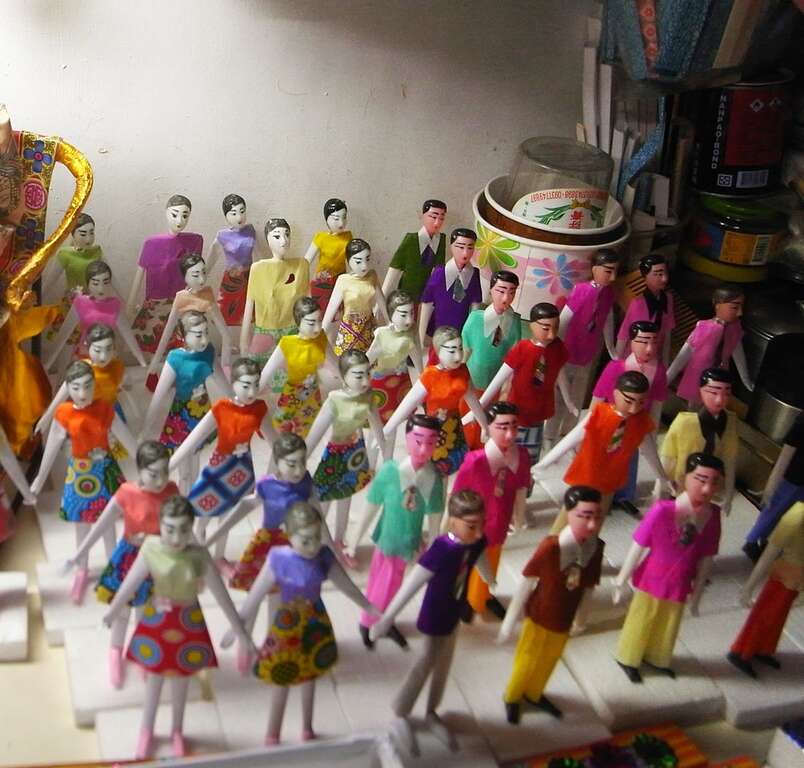 ▲▼Traditional paper effigies may seem creepy at first sight, but they are meant for blessings. (Photo・Zhang Xu Zhan)
▲▼Traditional paper effigies may seem creepy at first sight, but they are meant for blessings. (Photo・Zhang Xu Zhan)
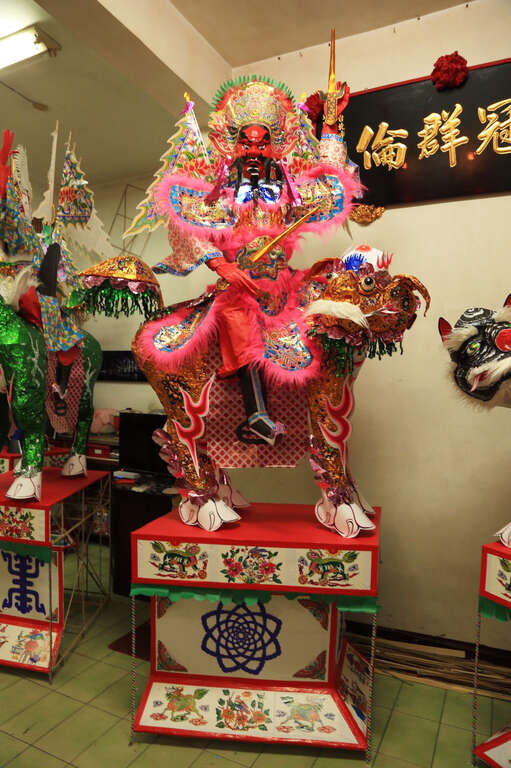
Eventually, these live offerings were replaced with pottery replicas, including the famous Terracotta Army of Qin Shi Huang, created in the 3rd century BCE, later discovered in Xian, China. Brightly-painted papier-mâché offerings built around thin bamboo structures then began to appear, most likely beginning as a folk custom before gaining popularity among the imperial elite.
One story of the origin of paper offering art dates back to Emperor Taizong of Tang, a famous ruler from the 7th century CE. Emperor Taizong's reign was marked by military campaigns against the Turkic peoples of Central Asia. These strengthened China but resulted in a great deal of death and destruction.
According to legend, Taizong's spirit once temporarily entered the underworld due to the mischievous actions of a deity. There he happened upon an endless sea of departed souls, many of whom died in battles he had waged. In Chinese mythology, ghosts
equire provisions just as humans do. However, these ghosts had nothing — no sustenance, no homes, no possessions. They begged Emperor Taizong for alms.
When Taizong returned to the physical realm, he had his minister create paper figures of the ghosts and chant sutras to help them cross into the next realm and seek peace. Another legend says Emperor Taizong had paper items created for the ghosts' wellbeing, burning them so that they could be sent to the afterlife.
Paper offerings did not enter common use in China until the Song Dynasty (960-1279 CE), long after Taizong's reign, as the technology of papermaking advanced a lot around the period. By the time the earliest settlers from southern Fujian brought the practice to Taiwan, it had become an art form passed down through families of skilled craftspeople. Though mass-produced paper offerings can be found online, some artisans continue the tradition of handmade offerings, including creating custom orders that reflect the desires of the recently departed, so that they may have in heaven what they coveted on earth.
These effigies might be very specific indeed. Imagine not just high-end electronics, but specifically an iPhone, or perhaps a Chanel or Birkin bag rather than a generic handbag. When it comes to transportation, offerings may depict not just any vehicle, but a Lamborghini or a Harley-Davidson.
An Ancient Art Thrives in Taipei
The Zhangs are one such family of paper artists. They have been in the paper art business since the late 19th century, when patriarch Zhang Genqi (張根乞) founded Mao Hsing Chai (茂興齋), a paper offering store in Dadaocheng (大稻埕), Taipei. Though the store has since moved to nearby Dalongdong (大龍峒), and the founder himself has crossed over to the other side, the Zhang family is still in the paper offering business more than a century later. They're known both for a tradition of carefully handmade goods, as well as artistic explorations into the more avant-garde uses of such art.
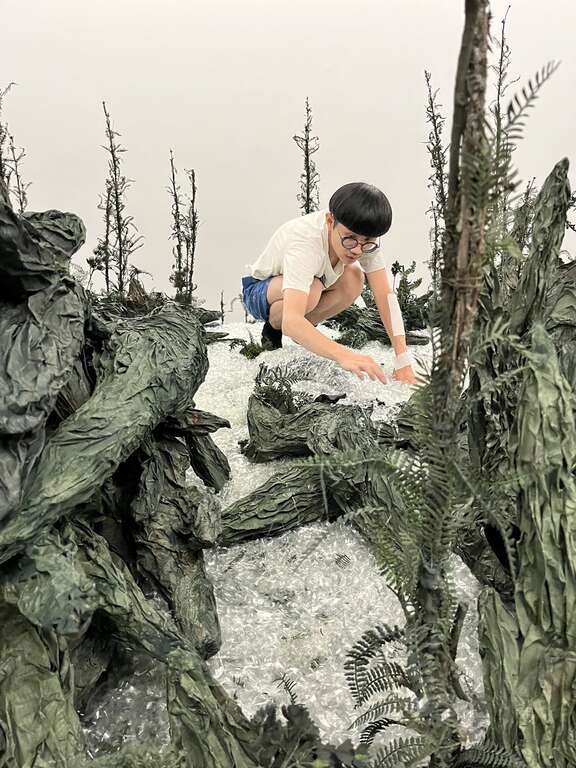 ▲Zhang Xu Zhan still believes that great effort perfects his artworks. (Photo・Zhang Xu Zhan)
▲Zhang Xu Zhan still believes that great effort perfects his artworks. (Photo・Zhang Xu Zhan)
"This is the precious spirit of traditional crafting,"notes Zhang Xu Zhan (張徐展), a fourth-generation scion of the family. "We insist on handmade paper offering. We believe that the things we paint and then burn for the deceased will be used in Elysium. Therefore, in order to show respect to the deceased, everything needs to be made with great effort. Our primary concern has always been whether the deceased can receive the offerings."
As a relatively young person dedicated to this ancient art, Zhang Xu Zhan approaches his work with a serious yet romantic mindset.
Bridging Tradition and Modernity
Beyond traditional paper offering art, Zhang Xu Zhan has made a name for himself in the global art scene. He has represented the family business at numerous international exhibitions, especially in France, where this unique art form has found appreciation for its craftsmanship and deep ties to Taiwanese culture.
In 2016, works by the Zhang family were included in the D'Days Festival held annually by the Department of Decorative Arts at the Louvre. Entitled Taiwan Unfolding, the exhibit was one of many that highlighted traditional arts from Taiwan.
In 2019, the Zhangs' work was again featured in the Palace Paradis exhibit at the Musée du Quai Branly in Paris. According to Zhang Xu Zhan, upcoming exhibitions will be held in Japan and Malaysia later this year, as well as an art festival in Jinguashi (金瓜石) on Taiwan's northeast coast.
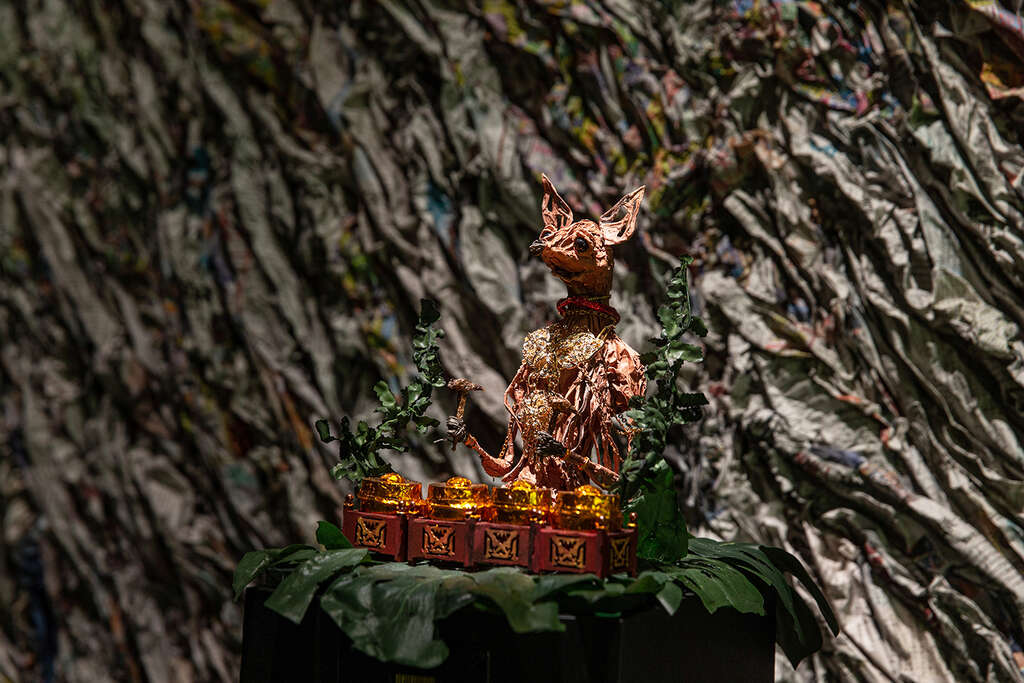 ▲Combining the traditional art with modern technology, Zhang Xu Zhan aims to bring new life to the paper art his family had handed down for generations. (Photo・Zhang Xu Zhan)
▲Combining the traditional art with modern technology, Zhang Xu Zhan aims to bring new life to the paper art his family had handed down for generations. (Photo・Zhang Xu Zhan)
As an artist, Zhang puts his observations and life experience into his family's traditional craft. "Traditional paper offering art is a kind of service, because we can only follow our customers' demands instead of having our own ideas," he says. "In contrast, I identify as an artist, and my creations can come from imagination. The traditional paper-offering industry creates for others, but artists create for themselves. I seek to connect these two opposite concepts."
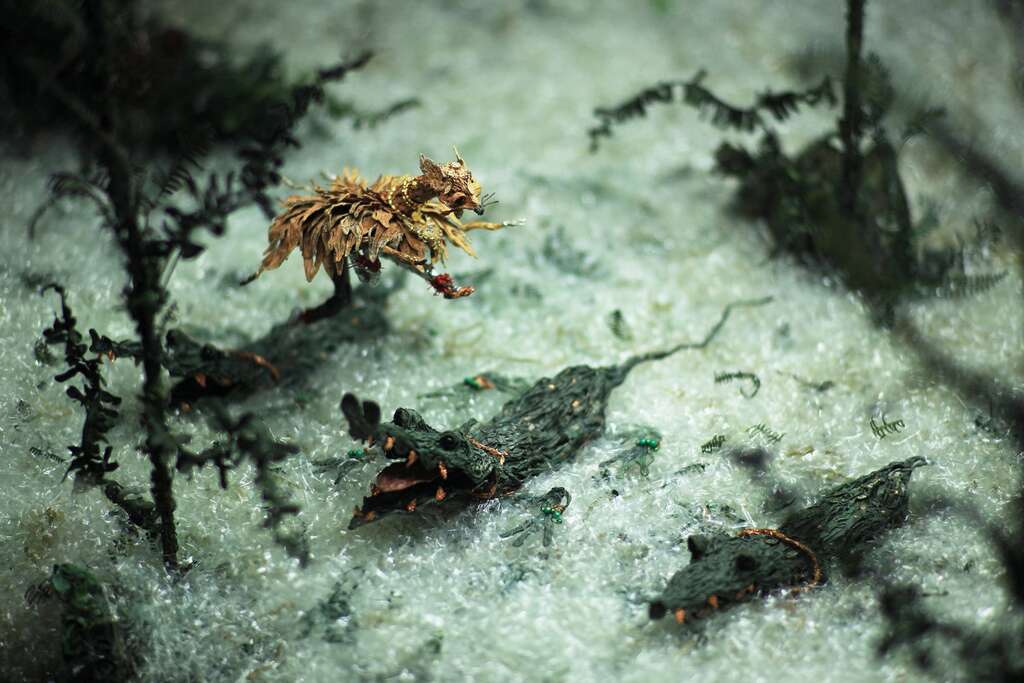 ▲Zhang Xu Zhan draws much inspiration from traditional folk tales and inteprets them with a brand new perspective. (Photo・Zhang Xu Zhan)
▲Zhang Xu Zhan draws much inspiration from traditional folk tales and inteprets them with a brand new perspective. (Photo・Zhang Xu Zhan)
Zhang is best known for award-winning short films incorporating his paper art. In 2022, his 16-minute film Compound Eyes of Tropical (熱帶複眼) won the award for Best Animated Short Film at the 59th annual Golden Horse Awards (金馬獎). The traditionally-crafted paper art in Compound Eyes of Tropical adapts a Southeast Asian folk tale called The Mouse-deer Crosses The River, and was shot using a frame-by-frame stop motion technique. The most well-known version follows a mouse-deer — a small Southeast Asian deer, also called a Chevrotain — who tricks crocodiles into forming a bridge in order to cross the river to eat some fruit.
Zhang's version tells the story through the perspective of a fly's compound eyes, using the word "tropical" to mean something more like "regional." The folk tale exists in many forms, and each culture understands it differently. In other words, there are "lots of eyes reading this folk tale," according to Zhang. "Different countries choose different animals to be characters," Zhang goes on. "For example, Japan chooses rabbits and sharks, while Taiwan chooses rats and buffalo. Compound Eyes of Tropical lets different animals act as the same character of the story."
Zhang continues to find inspiration in his roots. He describes his awards and accolades as not only for himself, but his family as well. "They felt honored and proud that the traditional paper art could be seen again through the new video art technology," Zhang says. "When the paper offering industry slumped, the old generation felt anxious about the future of this traditional art. However, after they saw that the old art is noticed and appreciated again with the assistance of modern technology, they feel that they are doing meaningful work."
Through Zhang's works, the paper offering art, once solely associated with the departed, is now also appreciated by the living.
Inspiration from the Old Times
Just as paper offering art is inextricably linked with Taiwanese culture, Zhang draws inspiration from his life and surroundings in Taipei. For example, his work often features mice and rats — in particular, a dead rat, which holds symbolic significance in his art.
"When seeing the dead flattened rat lying on the ground," Zhang explains, "I always think that they reflect human life. They are just like office workers. In workplaces, workers face many problems, but they are unable to solve the problems or make changes. Therefore, they can only helplessly see the problems happen."
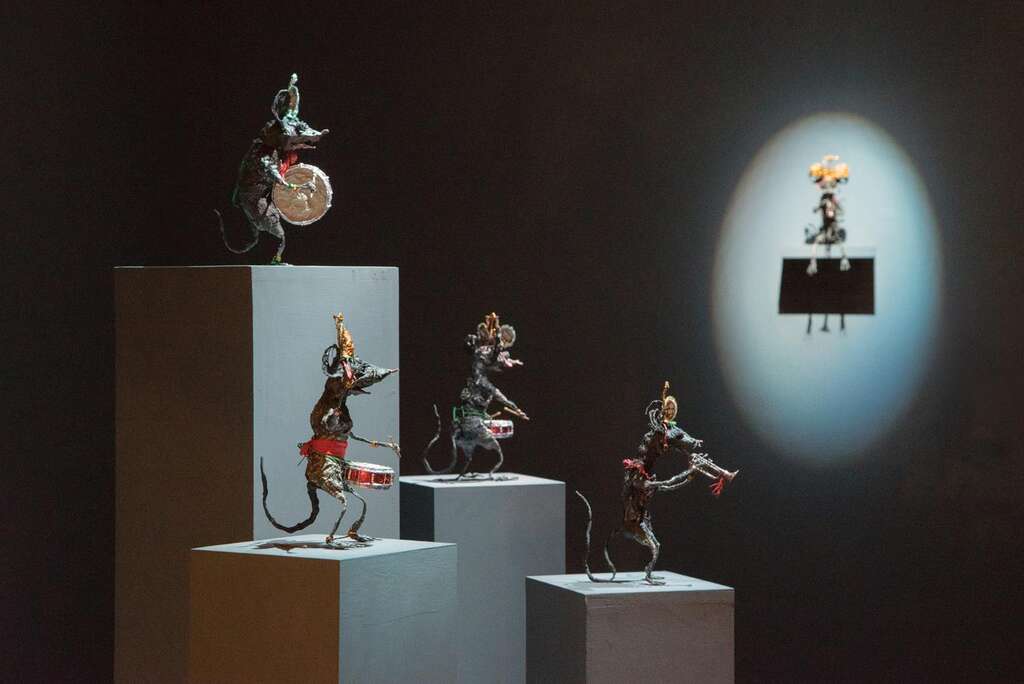 ▲Zhang Xu Zhan's work Si So Mi centers on the lowliness of animals' life and death, winning many international awards. (Photo・Zhang Xu Zhan)
▲Zhang Xu Zhan's work Si So Mi centers on the lowliness of animals' life and death, winning many international awards. (Photo・Zhang Xu Zhan)
Not all of Zhang's inspiration is so dark. In Taipei, he recommends the old "secret escape tunnels" in the Grand Hotel (圓山大飯店) at Yuanshan, and the Meet Bar (覓到酒吧) there, which is linked to the east tunnel. The tunnels were once escape routes, but now they are open for tourism. "Most of the time, the only function we can think of a building is to live, yet these tunnels defy our imagination — inside the building there are routes that lead to another place. Through these tunnels, we can also discover the interesting history of old Taipei."
In this dynamic city, Zhang's creative energy is boundless. Acting as something of a torchbearer, the legacy of paper offering art is poised to endure for generations, flourishing in the hands of not only the Zhang family, but of whoever finds this art form as vital and captivating as they have for well over a hundred years.
An Ancient Blessing Culture: The Story of Paper Art
Author Jenna Lynn Cody
Photographer Hsin Hsin Paper Offering Store, Zhang Xu Zhan
 ▲Taiwan's traditional paper offering art has been exhibited for the second time in Paris, allowing the world to see. (Photo・Hsin Hsin Paper Offering Store)
▲Taiwan's traditional paper offering art has been exhibited for the second time in Paris, allowing the world to see. (Photo・Hsin Hsin Paper Offering Store)Imagine an opulent mansion. Perhaps it's anachronistic in design and covered in improbably bright shades of pink, green or yellow. Perhaps, instead, it is sleekly modern, done in neutral tones — what a wealthy person living in Taiwan today might build for themselves. Add to your mansion a luxury car, a designer handbag and shoes, and all the money you could ever want.
You might see these items, rendered in uncannily realistic detail, at a Taiwanese funeral, or ceremony paying respects to those no longer with us. All of them are painstakingly rendered in paper and bamboo, and all of them will go up in flames. They're not for us; they're for the afterlife.
Paper offerings take on special meaning in early April, when Taiwanese people visit their ancestors' graves. Both paper money and more elaborate paper offerings are often burned to pay one's respects to those who have passed on. Although the art of paper offerings is thousands of years old and found in Chinese-speaking communities around the world, Taiwanese paper artists have been breaking new ground with creative paper renderings and even short films. Such art has garnered significant international attention, including multiple feature exhibitions in France, such as one that took place at Musée du Quai Branly, among others.
When learning about paper offering art, one must consider not only its history and cultural connotations, but also the ways it has transformed itself into a modern art form for contemporary audiences.
Paper Art Through Life and Death
Paper offerings, called Zhizha (紙紮) in Chinese, originated in ancient China. Differing accounts place their first appearance as early as the Three Kingdoms era in the 3rd century CE, or the Tang Dynasty several centuries later. The practice stemmed from archaic burial customs. As with many cultures around the world, the wealthy in ancient China would be sent to the supernatural realm with a dazzling array of material goods. Sometimes, such riches would include live humans and animals, especially horses. There are also stories of such offerings — including living beings — to various Taoist and folk gods.
 ▲▼Traditional paper effigies may seem creepy at first sight, but they are meant for blessings. (Photo・Zhang Xu Zhan)
▲▼Traditional paper effigies may seem creepy at first sight, but they are meant for blessings. (Photo・Zhang Xu Zhan)
Eventually, these live offerings were replaced with pottery replicas, including the famous Terracotta Army of Qin Shi Huang, created in the 3rd century BCE, later discovered in Xian, China. Brightly-painted papier-mâché offerings built around thin bamboo structures then began to appear, most likely beginning as a folk custom before gaining popularity among the imperial elite.
One story of the origin of paper offering art dates back to Emperor Taizong of Tang, a famous ruler from the 7th century CE. Emperor Taizong's reign was marked by military campaigns against the Turkic peoples of Central Asia. These strengthened China but resulted in a great deal of death and destruction.
According to legend, Taizong's spirit once temporarily entered the underworld due to the mischievous actions of a deity. There he happened upon an endless sea of departed souls, many of whom died in battles he had waged. In Chinese mythology, ghosts
equire provisions just as humans do. However, these ghosts had nothing — no sustenance, no homes, no possessions. They begged Emperor Taizong for alms.
When Taizong returned to the physical realm, he had his minister create paper figures of the ghosts and chant sutras to help them cross into the next realm and seek peace. Another legend says Emperor Taizong had paper items created for the ghosts' wellbeing, burning them so that they could be sent to the afterlife.
Paper offerings did not enter common use in China until the Song Dynasty (960-1279 CE), long after Taizong's reign, as the technology of papermaking advanced a lot around the period. By the time the earliest settlers from southern Fujian brought the practice to Taiwan, it had become an art form passed down through families of skilled craftspeople. Though mass-produced paper offerings can be found online, some artisans continue the tradition of handmade offerings, including creating custom orders that reflect the desires of the recently departed, so that they may have in heaven what they coveted on earth.
These effigies might be very specific indeed. Imagine not just high-end electronics, but specifically an iPhone, or perhaps a Chanel or Birkin bag rather than a generic handbag. When it comes to transportation, offerings may depict not just any vehicle, but a Lamborghini or a Harley-Davidson.
An Ancient Art Thrives in Taipei
The Zhangs are one such family of paper artists. They have been in the paper art business since the late 19th century, when patriarch Zhang Genqi (張根乞) founded Mao Hsing Chai (茂興齋), a paper offering store in Dadaocheng (大稻埕), Taipei. Though the store has since moved to nearby Dalongdong (大龍峒), and the founder himself has crossed over to the other side, the Zhang family is still in the paper offering business more than a century later. They're known both for a tradition of carefully handmade goods, as well as artistic explorations into the more avant-garde uses of such art.
 ▲Zhang Xu Zhan still believes that great effort perfects his artworks. (Photo・Zhang Xu Zhan)
▲Zhang Xu Zhan still believes that great effort perfects his artworks. (Photo・Zhang Xu Zhan)"This is the precious spirit of traditional crafting,"notes Zhang Xu Zhan (張徐展), a fourth-generation scion of the family. "We insist on handmade paper offering. We believe that the things we paint and then burn for the deceased will be used in Elysium. Therefore, in order to show respect to the deceased, everything needs to be made with great effort. Our primary concern has always been whether the deceased can receive the offerings."
As a relatively young person dedicated to this ancient art, Zhang Xu Zhan approaches his work with a serious yet romantic mindset.
Bridging Tradition and Modernity
Beyond traditional paper offering art, Zhang Xu Zhan has made a name for himself in the global art scene. He has represented the family business at numerous international exhibitions, especially in France, where this unique art form has found appreciation for its craftsmanship and deep ties to Taiwanese culture.
In 2016, works by the Zhang family were included in the D'Days Festival held annually by the Department of Decorative Arts at the Louvre. Entitled Taiwan Unfolding, the exhibit was one of many that highlighted traditional arts from Taiwan.
In 2019, the Zhangs' work was again featured in the Palace Paradis exhibit at the Musée du Quai Branly in Paris. According to Zhang Xu Zhan, upcoming exhibitions will be held in Japan and Malaysia later this year, as well as an art festival in Jinguashi (金瓜石) on Taiwan's northeast coast.
 ▲Combining the traditional art with modern technology, Zhang Xu Zhan aims to bring new life to the paper art his family had handed down for generations. (Photo・Zhang Xu Zhan)
▲Combining the traditional art with modern technology, Zhang Xu Zhan aims to bring new life to the paper art his family had handed down for generations. (Photo・Zhang Xu Zhan)As an artist, Zhang puts his observations and life experience into his family's traditional craft. "Traditional paper offering art is a kind of service, because we can only follow our customers' demands instead of having our own ideas," he says. "In contrast, I identify as an artist, and my creations can come from imagination. The traditional paper-offering industry creates for others, but artists create for themselves. I seek to connect these two opposite concepts."
 ▲Zhang Xu Zhan draws much inspiration from traditional folk tales and inteprets them with a brand new perspective. (Photo・Zhang Xu Zhan)
▲Zhang Xu Zhan draws much inspiration from traditional folk tales and inteprets them with a brand new perspective. (Photo・Zhang Xu Zhan) Zhang is best known for award-winning short films incorporating his paper art. In 2022, his 16-minute film Compound Eyes of Tropical (熱帶複眼) won the award for Best Animated Short Film at the 59th annual Golden Horse Awards (金馬獎). The traditionally-crafted paper art in Compound Eyes of Tropical adapts a Southeast Asian folk tale called The Mouse-deer Crosses The River, and was shot using a frame-by-frame stop motion technique. The most well-known version follows a mouse-deer — a small Southeast Asian deer, also called a Chevrotain — who tricks crocodiles into forming a bridge in order to cross the river to eat some fruit.
Zhang's version tells the story through the perspective of a fly's compound eyes, using the word "tropical" to mean something more like "regional." The folk tale exists in many forms, and each culture understands it differently. In other words, there are "lots of eyes reading this folk tale," according to Zhang. "Different countries choose different animals to be characters," Zhang goes on. "For example, Japan chooses rabbits and sharks, while Taiwan chooses rats and buffalo. Compound Eyes of Tropical lets different animals act as the same character of the story."
Zhang continues to find inspiration in his roots. He describes his awards and accolades as not only for himself, but his family as well. "They felt honored and proud that the traditional paper art could be seen again through the new video art technology," Zhang says. "When the paper offering industry slumped, the old generation felt anxious about the future of this traditional art. However, after they saw that the old art is noticed and appreciated again with the assistance of modern technology, they feel that they are doing meaningful work."
Through Zhang's works, the paper offering art, once solely associated with the departed, is now also appreciated by the living.
Inspiration from the Old Times
Just as paper offering art is inextricably linked with Taiwanese culture, Zhang draws inspiration from his life and surroundings in Taipei. For example, his work often features mice and rats — in particular, a dead rat, which holds symbolic significance in his art.
"When seeing the dead flattened rat lying on the ground," Zhang explains, "I always think that they reflect human life. They are just like office workers. In workplaces, workers face many problems, but they are unable to solve the problems or make changes. Therefore, they can only helplessly see the problems happen."
 ▲Zhang Xu Zhan's work Si So Mi centers on the lowliness of animals' life and death, winning many international awards. (Photo・Zhang Xu Zhan)
▲Zhang Xu Zhan's work Si So Mi centers on the lowliness of animals' life and death, winning many international awards. (Photo・Zhang Xu Zhan)Not all of Zhang's inspiration is so dark. In Taipei, he recommends the old "secret escape tunnels" in the Grand Hotel (圓山大飯店) at Yuanshan, and the Meet Bar (覓到酒吧) there, which is linked to the east tunnel. The tunnels were once escape routes, but now they are open for tourism. "Most of the time, the only function we can think of a building is to live, yet these tunnels defy our imagination — inside the building there are routes that lead to another place. Through these tunnels, we can also discover the interesting history of old Taipei."
In this dynamic city, Zhang's creative energy is boundless. Acting as something of a torchbearer, the legacy of paper offering art is poised to endure for generations, flourishing in the hands of not only the Zhang family, but of whoever finds this art form as vital and captivating as they have for well over a hundred years.
Gallery
:::
Popular articles
 Spring Days & Green Healing on Yangmingshan (TAIPEI Quarterly 2024 Spring Vol.35)
Spring Days & Green Healing on Yangmingshan (TAIPEI Quarterly 2024 Spring Vol.35) Exploring Urban Picnic Paradises: Health-Nourishing Fun in the Sun (TAIPEI Quarterly 2024 Spring Vol.35)
Exploring Urban Picnic Paradises: Health-Nourishing Fun in the Sun (TAIPEI Quarterly 2024 Spring Vol.35) Meet You in Zhongshan: The Ins and Outs of Taipei's Coolest Neighborhood (TAIPEI Quarterly 2024 Spring Vol.35)
Meet You in Zhongshan: The Ins and Outs of Taipei's Coolest Neighborhood (TAIPEI Quarterly 2024 Spring Vol.35) Flow in the City: Street Dance Evolution in Taipei (TAIPEI Quarterly 2024 Spring Vol.35)
Flow in the City: Street Dance Evolution in Taipei (TAIPEI Quarterly 2024 Spring Vol.35) An Ancient Blessing Culture: The Story of Paper Art (TAIPEI Quarterly 2024 Spring Vol.35)
An Ancient Blessing Culture: The Story of Paper Art (TAIPEI Quarterly 2024 Spring Vol.35) Sports City — Taipei's New Future (TAIPEI Quarterly 2024 Spring Vol.35)
Sports City — Taipei's New Future (TAIPEI Quarterly 2024 Spring Vol.35)
 An Ancient Blessing Culture: The Story of Paper Art (TAIPEI Quarterly 2024 Spring Vol.35)
An Ancient Blessing Culture: The Story of Paper Art (TAIPEI Quarterly 2024 Spring Vol.35)